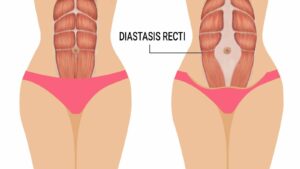Diastasis rectus is a condition that affects many people. It can cause pain and discomfort and can make everyday activities difficult to perform. If you are suffering from diastasis recti, you may be wondering how it can be treated. In this blog post, we will discuss the various treatment options available for diastasis recti. We will also provide tips on how to reduce the symptoms of this condition.
Contents
What is Diastasis Recti?
Diastasis recti, also known as rectus abdominal diastasis, is characterized by a separation between the left and right sides of the rectus abdominis muscle of at least 2.7 cm. The muscle covers the front portion of the belly. Diastasis recti can occur in both men and women, however, it is more common in pregnant and postpartum women.
Symptoms of Diastasis Recti

Symptoms of diastasis recti include:
- a bulging or protruding belly,
- lower back pain, and
- difficulty performing specific movements such as sit-ups or lifting a heavy object
Physical examination alone cannot treat diastasis recti. A healthcare professional may use ultrasound imaging to confirm the presence of separation in the rectus abdominis muscle.
Treatment of Diastasis Recti
The first physiotherapy treatment step is still being disputed on which regimen works best, while success rates are not documented. The next stage is surgery which can be either open or laparoscopic. Both types of surgical approaches have high success rates and include different plication techniques with low recurrence and complication rates. Complications from the surgery are minor and improve quality of life in patients as well as reduce low back pain and urinary incontinence However, robotic-assisted surgery might become a possibility in the future, though data is currently insufficient.
Physiotherapy
Although there is no guarantee of success, conservative (non-surgical) treatment for rectus diastasis may be started by referral from a medical doctor to a physiotherapist. We suggest that this type of therapy begins 6 to 8 weeks post-partum, as has been chosen in some studies.
Open Surgery
Open surgery has a high success rate, with most studies reporting a 0% recurrence rate six months after the procedure. The classic abdominoplasty is the most widely used open approach. This involves making a transverse suprapubic incision extended laterally to the anterior iliac crests in order to visualize the rectus muscles and linea alba.
Laparoscopic Surgery
Most studies report that the success rate for laparoscopic surgery is high, with a 0% recurrence rate six months after the procedure. When diastasis and ventral hernia occur together, a laparoscopic technique is commonly used; however, this method can also be employed when treating abdominal rectus diastasis by itself.
Diastasis Recti Affecting Genders Differently
Women who are pregnant or just gave birth are most likely to experience diastasis recti, although it can also affect males and newborns. Diastasis Recti affects almost 60% of pregnant and postpartum women, say the stats. Usually, it goes away eight weeks after delivery. By six months postpartum, over 40% of people with diastasis recti still suffer from it.
Although diastasis recti do not discriminate based on age or gender, there are still differences in how these groups are treated. Let’s go in-depth about each category’s treatments.
For Women

Early in pregnancy, diastasis recti is frequently not noticeable, but later, in the second or third trimester, when the uterus protrudes beyond the abdominal muscles, you could notice a bulge or ridge forming on your abdomen. It could show up above or below the belly button. When you’re attempting to get up, sit upright, or lay down while using your ab muscles, it can be the most obvious.
Your course of treatment will be based on the severity of your abdominal separation. If the gap is less than 4cms, as measured by the width between your fingers, then you can begin with corrective exercises. This should help bring the two bellies of your rectus abdominis muscle closer together. For most people, this exercise regime lasts anywhere from 2 to 6 weeks until either the separation has closed up or is down to less than 2cms wide.
Your body’s core muscles, located in your abdomen and lower back, provide support for your spine and help you move correctly. These inner-core muscles include the:
- Diaphragm (your main breathing muscle)
- Multifidus (a deep back muscle)
- Transversus abdominis (the equivalent of a corset for your body)
- Pelvic floor muscles
For Men
In general, diastasis that is 5mm or less in size is treated with regular exercise. If the separation is greater than 5cm, then you will require the help of surgery. Therapy often consists of exercises meant to bring the muscles closer together again. Avoiding certain types of exercises is also key to successful recovery. It typically takes 4 weeks for any healing effects to start Kicking in and up to 12 weeks for full results.
If you have diastasis recti, there are a few things that may help improve the condition. For one, strengthening the core muscles can help stabilize the abdomen and improve posture. Additionally, in severe cases or if other methods haven’t worked, surgery may be an effective solution. Finally, weight loss may also help shrink smaller instances of diastasis recti.
For Children
Diastasis Rectus is common among newborns and infants, as their abdominal muscles are still developing. In most cases, the condition will improve on its own without any intervention. However, if diastasis recti persist past infancy or worsens over time, physical therapy can help strengthen and tighten the muscles.
Playful exercises and physical therapists treat children with this condition. These exercises focus on strengthening the transverse abdominal muscles to support the abdomen. In severe cases, surgery may be necessary to correct the separation of the rectus abdominis muscle.
They should avoid activities that put excessive pressure on the abdominal muscles, such as sit-ups or crunches.
Fixing Diastasis Recti With Exercise
 Sit-ups, twists, backward bends, and complex yoga pose you must avoid doing at all costs. Excessive stretching of the abdomen can cause injury. Building inner muscle strength is what the expert recommends before moving on to more advanced stomach exercises.
Sit-ups, twists, backward bends, and complex yoga pose you must avoid doing at all costs. Excessive stretching of the abdomen can cause injury. Building inner muscle strength is what the expert recommends before moving on to more advanced stomach exercises.
The best way to reduce separation (of the Rectus Abdominis – outer layer from the Transverse Abs – deep layer) is by holding tension in your deep abdominal muscles with a neutral spine while lying on your back on the floor.
You should hold these exercises for longer periods of time with greater loads/resistance. If you’re looking for alternatives to the traditional workout, try planks, push-ups, and pelvic floor exercises. Some therapists also use braces or neuromuscular electrical stimulation.
Is It Ever Too Late To Heal Diastasis Recti?
It’s NEVER too late to heal diastasis recti, as the connective tissue in our bodies is always capable of repairing and strengthening. However, it may take longer for postpartum women or those who have had the condition for a longer period of time to see results.
Abdominal exercises target core strength and rebuild the closing gap between the abdominal muscles. You should perform exercises only under the guidance of a qualified physical therapist or a personal trainer because doing exercises incorrectly will cost you by worsening your diastasis recti.
Conclusion
To sum up, patients with abdominal rectus diastasis who experience symptoms in addition to the bulge should see a physiotherapist. We don’t yet have enough evidence to determine which conservatory treatment is best, and more research needs to be done in this area. If conservatory treatments don’t work well, surgery may be an option. Open or laparoscopic surgery are both viable options—the type of surgery that’s right for each patient depends on several factors such as how much excess skin there is and whether or not
Moreover, if you are struggling to find the right treatment then contact Mantra Care for assistance. With years of experience in the field, we can help you connect with the right professional for your needs.
Physical Therapy help patients recover from pain. If you’re experiencing Back pain, Shoulder pain, Knee pain, Neck pain, Elbow pain, Hip pain, or Arthritis pain, a physical therapist at MantraCare can help: Book a physiotherapy session.


